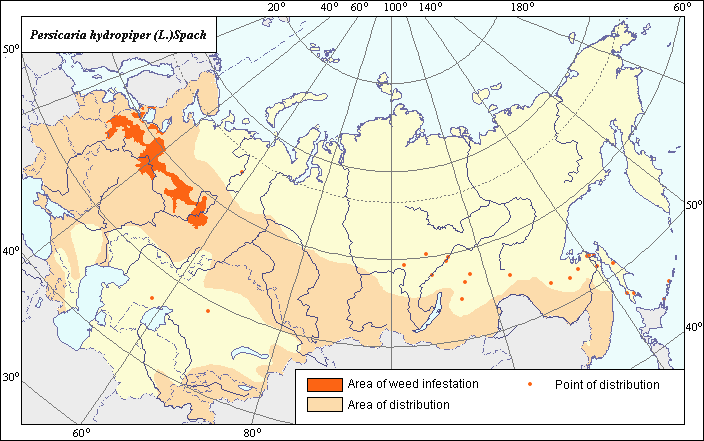Weeds
Area of distribution and weediness of Persicaria hydropiper (L.) Spach
 Object description Download GIS-layers
Object description Download GIS-layers
Authors:
Specialist biologist - S.Yu.Larina,GIS-specialist - I.A.Budrevskaya.
Date of creation:
16.06.2006.Scale:
1:20 000 000.Accuracy of the map:
It is created on materials of maps of natural scale 1:5 000 000 - 1:17 000 000.Projection:
"Alber's Equal Area Conic for the USSR", 9, 1001, 7, 100, 0, 44, 68, 0, 0.Basic content:
Vector map. Area of distribution is shown by polygon (main distribution) and by dots (sporadic distribution). Zone of weediness is shown by polygon.Accuracy of the classifier:
The zones of P. hydropiper weediness are shown within the weed area, established by criteria of occurrence (% of fields where this species is found) and abundance (expressed as projective cover of this species in field in % to the field area) (Tanskii et al., 1998), i.e.; where the occurrence of this species exceeded 20% with its abundance (projective cover) more than 15%.Method of map production:
The areas of distribution and weediness of P. hydropiper are established according to the analysis of the open published maps and literature. The area of distribution is based on the map from the publication of P.S.Chikov (1983). The zones of weediness are established according to V.V.Nikitin (1983) and E.V.Shlyakova (1982), and coordinated with the limits of arable land. The sites of sporadic distribution of P. hydropiper are depicted according to P.S.Chikov (1983), S.S.Kharkevich (1989), A.I.Tolmachev (1976), A.A.Grossgeim (1945), and I.M.Krasnoborov (1992); part of them is supported by the data of P.S.Chikov (1983), included in the main area.Reference citations:
Anon. 1996-2003. Polygonum hydropiper. Plants for a Future Database. http://www.pfaf.org/database/plants.php?Polygonum+hydropiperChikov, P.S., ed. 1983. Atlas of areas and resources of herbs of the USSR. Moscow: GUGK. 340 p. (in Russian).
Grossgeim, A.A. 1945. Flora of the Caucasus. V.3. Baku: AN Azerb.SSR. 321 p. (in Russian).
Gubanov, I.A., Kiseleva, K.V., Novikov, V.S., Tikhomirov, V.N. 2003. Illustrated keys to plants of Middle Russia. V. 2. Moscow: KMK. 665 p. (in Russian).
Keller, B.A., ed. 1934. Weed plants of the USSR. V. 3. Leningrad: AN SSSR. 448 p. (in Russian).
Kharkevich, S.S., ed.1989. Vascular plants of the Soviet Far East. V.4. Leningrad: Nauka. 378 p. (in Russian).
Komarov, V.L., ed. 1936. Flora of the USSR. V. 5. Moscow-Leningrad: AN SSSR. 762 p. (in Russian).
Krasnoborov, I.M. & Malyshev, L.I., eds. 1992. Flora of Siberia. V. 5. Novisibirsk: Nauka. 312 p. (in Russian).
Nikitin, V.V. 1983. Weed plants of the USSR flora. Leningrad: Nauka. 454 p. (in Russian).
Shlyakova, E.V. 1982. Keys to field weed plants of Non-Chernozem zone. Leningrad: Ko-los. 208 p. (in Russian).
Tanskii, V.I., Levitin M.M., Ishkova T.I. & Kondratenko, V.I. 1998. Phytosanitary diagnostics in integrated management of cereals. In: Novozhilov, K.V., ed. Compendium of methodical recommendations in plant protection. Saint-Petersburg: VIZR. p.5-55. (in Russian).
Tolmachev, A.I., ed. 1976. Flora of Northeast of the European part of the USSR. V. 2. Leningrad: Nauka. 316 p. (in Russian).
Tsitsin, N.V., ed. 1962. Atlas of medicinal plants of the USSR. Moscow: State Publishing House of Medicinal Literature. 704 p. (in Russian).

